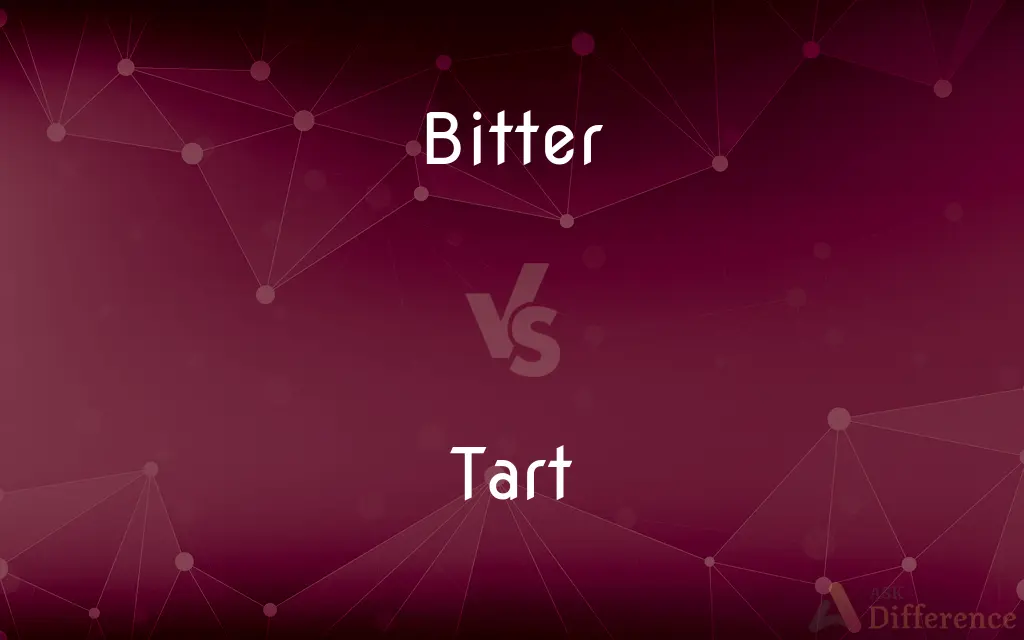Bitter vs. Tart — What's the Difference?
Edited by Tayyaba Rehman — By Urooj Arif — Updated on March 29, 2024
Bitter is a taste associated with unsweetened cocoa, coffee, and some greens, emphasizing a sharp, often unpleasant flavor; tart is a taste found in citrus fruits and some berries, combining sourness with sweetness.

Difference Between Bitter and Tart
Table of Contents
ADVERTISEMENT
Key Differences
Bitterness is a basic taste characterized by a sharp, pungent flavor that can be perceived as unpleasant or undesirable in high concentrations. Foods and beverages like unsweetened chocolate, coffee, and certain leafy greens are known for their bitter taste. This taste is often associated with toxicity in nature, serving as a warning sign for potentially harmful substances. On the other hand, tartness is a taste that combines elements of sweetness and sourness, leading to a sharp but generally pleasant flavor profile. Tart flavors are typical in fruits such as lemons, cranberries, and certain apples, offering a refreshing and often invigorating taste experience.
While bitterness is largely considered undesirable in large amounts, it plays an essential role in balancing the flavor profile of many dishes and beverages. It can add depth and complexity, enhancing the overall sensory experience. Tartness, however, is often sought after for its ability to stimulate the palate and complement sweet flavors. The balance between sour and sweet that defines a tart taste can make certain foods and drinks more appealing and refreshing.
The perception of bitterness is mediated by a variety of bitter taste receptors in the mouth, which evolved to help detect potentially toxic compounds in food. As such, people's sensitivity to bitter tastes can vary widely, influencing their dietary preferences. Conversely, tartness is primarily detected through the sour taste receptors, which respond to acidity. The degree of tartness is influenced by the concentration of acidic compounds in the food or drink, as well as its sugar content, which can mitigate the perceived sourness.
In culinary applications, bitter flavors are often incorporated intentionally to create a more balanced and complex taste profile. For example, the bitterness of dark chocolate or coffee can enhance the richness of desserts and beverages. Tart flavors, by contrast, are frequently used to add a vibrant, refreshing quality to dishes, cutting through richness and sweetness with their crisp sourness.
In summary, while both bitter and tart tastes play crucial roles in the culinary world, they differ significantly in their sensory impact and the ways in which they are appreciated and used. Bitterness often serves as a balancing element or warning, whereas tartness is prized for its refreshing qualities and its ability to enhance sweetness.
ADVERTISEMENT
Comparison Chart
Basic Taste
One of the basic tastes, often perceived as sharp and potentially unpleasant.
A combination of sour and sweet, generally pleasant and refreshing.
Common Sources
Unsweetened cocoa, coffee, certain greens and herbs.
Citrus fruits, cranberries, some berries, and apples.
Sensory Role
Can signal toxicity, used to balance and add complexity to flavors.
Stimulates the palate, complements and balances sweetness.
Perception
Mediated by various bitter taste receptors, with a wide range of sensitivity among individuals.
Detected through sour taste receptors, influenced by acidity and mitigated by sweetness.
Culinary Application
Used intentionally in small amounts for flavor balance and complexity.
Used to add vibrancy, refreshment, and to cut through richness.
Compare with Definitions
Bitter
A basic taste sensation noted for its sharpness and often unpleasant quality.
The bitter taste of raw kale can be softened by cooking.
Tart
Describes foods or beverages with a sharp and pleasantly sour taste.
She enjoyed the tart taste of green apples.
Bitter
Used in culinary arts to balance sweetness and richness.
A hint of bitter in the cake added an intriguing depth to its flavor.
Tart
Influenced by the acidity of the food and its sugar content.
Adjusting the sugar in the recipe can reduce the tartness.
Bitter
Detected by specific receptors in the taste buds.
Genetic variations affect how bitter tastes are perceived.
Tart
A taste that combines sourness with a hint of sweetness, often found in fruits.
The tart flavor of the lemonade was refreshing.
Bitter
Characterized by a lack of sweetness and a pungent flavor.
Dark chocolate is loved for its rich, bitter taste.
Tart
Used to refer to the vibrant, often citrusy flavor that stimulates the palate.
The tart dressing made the salad come alive.
Bitter
Associated with substances that can signal potential harm.
The bitter flavor of certain medications is masked with sweeteners.
Tart
A culinary characteristic sought after for its ability to complement and balance richer, sweeter profiles.
The tart berry compote was the perfect topping for the sweet cheesecake.
Bitter
Having or being a taste that is sharp, acrid, and unpleasant.
Tart
A tart is a baked dish consisting of a filling over a pastry base with an open top not covered with pastry. The pastry is usually shortcrust pastry; the filling may be sweet or savoury, though modern tarts are usually fruit-based, sometimes with custard.
Bitter
Causing a sharply unpleasant, painful, or stinging sensation; harsh
Enveloped in bitter cold.
A bitter wind.
Tart
Having a sharp pungent taste; sour.
Bitter
Difficult or distasteful to accept, admit, or bear
The bitter truth.
Bitter sorrow.
Tart
Sharp or bitter in tone or meaning; cutting.
Bitter
Proceeding from or exhibiting strong animosity
A bitter struggle.
Bitter foes.
Tart
A pastry shell with shallow sides, no top crust, and any of various fillings.
Bitter
Resulting from or expressive of severe grief, anguish, or disappointment
Cried bitter tears.
Tart
Chiefly British A pie.
Bitter
Marked by resentment or cynicism
"He was already a bitter elderly man with a gray face" (John Dos Passos).
Tart
A prostitute.
Bitter
In an intense or harsh way; bitterly
A bitter cold night.
Tart
To dress up or make fancy in a tawdry, garish way. Often used with up.
Bitter
To make bitter.
Tart
Sharp to the taste; acid; sour.
I ate a very tart apple.
Bitter
That which is bitter
"all words ... / Failing to give the bitter of the sweet" (Tennyson).
Tart
(of wine) high or too high in acidity.
Bitter
Bitters A bitter, usually alcoholic liquid made with herbs or roots and used in cocktails or as a tonic.
Tart
(figuratively) Sharp; keen; severe.
He gave me a very tart reply.
Bitter
Chiefly British A sharp-tasting beer made with hops.
Tart
A type of small open pie, or piece of pastry, containing jelly or conserve; a sort of fruit pie.
Bitter
Having an acrid taste (usually from a basic substance).
The coffee tasted bitter.
Tart
A melt block of wax for use in a tart burner.
Bitter
Harsh, piercing or stinging.
Tart
A prostitute.
Bitter
Hateful or hostile.
They're bitter enemies.
Tart
To practice prostitution.
Bitter
Cynical and resentful.
I've been bitter ever since that defeat.
Tart
To dress garishly, ostentatiously, whorishly, or sluttily.
Bitter
(usually in the plural bitters) A liquid or powder, made from bitter herbs, used in mixed drinks or as a tonic.
Tart
Sharp to the taste; acid; sour; as, a tart apple.
Bitter
A type of beer heavily flavored with hops.
Tart
Fig.: Sharp; keen; severe; as, a tart reply; tart language; a tart rebuke.
Why art thou tart, my brother?
Bitter
(nautical) A turn of a cable about the bitts.
Tart
A species of small open pie, or piece of pastry, containing jelly or conserve; a sort of fruit pie.
Bitter
A hardware system whose architecture is based around units of the specified number of bits binary digits.
Tart
A small open pie with a fruit filling
Bitter
To make bitter.
Tart
Pastry cup with a filling of fruit or custard and no top crust
Bitter
AA turn of the cable which is round the bitts.
Tart
Tasting sour like a lemon
Bitter
Any substance that is bitter. See Bitters.
Tart
Harsh;
Sharp criticism
A sharp-worded exchange
A tart remark
Bitter
Having a peculiar, acrid, biting taste, like that of wormwood or an infusion of hops; as, a bitter medicine; bitter as aloes.
Bitter
Causing pain or smart; piercing; painful; sharp; severe; as, a bitter cold day.
Bitter
Causing, or fitted to cause, pain or distress to the mind; calamitous; poignant.
It is an evil thing and bitter, that thou hast forsaken the Lord thy God.
Bitter
Characterized by sharpness, severity, or cruelty; harsh; stern; virulent; as, bitter reproach.
Husbands, love your wives, and be not bitter against them.
Bitter
Mournful; sad; distressing; painful; pitiable.
The Egyptians . . . made their lives bitter with hard bondage.
Bitter
To make bitter.
Bitter
English term for a dry sharp-tasting ale with strong flavor of hops (usually on draft)
Bitter
The taste experience when quinine or coffee is taken into the mouth
Bitter
The property of having a harsh unpleasant taste
Bitter
Make bitter
Bitter
Marked by strong resentment or cynicism;
An acrimonious dispute
Bitter about the divorce
Bitter
Very difficult to accept or bear;
The bitter truth
A bitter sorrow
Bitter
Harsh or corrosive in tone;
An acerbic tone piercing otherwise flowery prose
A barrage of acid comments
Her acrid remarks make her many enemies
Bitter words
Blistering criticism
Caustic jokes about political assassination, talk-show hosts and medical ethics
A sulfurous denunciation
Bitter
One of the four basic taste sensations; sharp and disagreeable; like the taste of quinine
Bitter
Expressive of severe grief or regret;
Shed bitter tears
Bitter
Proceeding from or exhibiting great hostility or animosity;
A bitter struggle
Bitter enemies
Bitter
Causing a sharply painful or stinging sensation; used especially of cold;
Bitter cold
A biting wind
Bitter
Extremely and sharply;
It was bitterly cold
Bitter cold
Common Curiosities
Can a food be both bitter and tart?
Yes, some foods may have both bitter and tart characteristics, depending on their acidity and the presence of certain compounds.
What makes a taste bitter?
A taste is considered bitter if it is sharp, pungent, and often perceived as unpleasant, typically signaling potential toxicity.
Why do some people dislike tart flavors?
While tart flavors are generally liked for their refreshing quality, individual preferences vary, and some may find the combination of sourness and sweetness less appealing.
Is tartness the same as sourness?
Tartness includes sourness but is often accompanied by a degree of sweetness, distinguishing it from pure sourness.
Why is tartness appealing in beverages?
Tartness in beverages can stimulate the palate and provide a refreshing contrast to sweetness, enhancing the overall drinking experience.
How can I reduce bitterness in food?
Bitterness in food can be reduced by cooking, adding sweetness, or incorporating fats or salts to balance the flavor.
Do bitter tastes have any health benefits?
Bitter-tasting foods often contain beneficial nutrients and compounds, such as antioxidants, that can contribute to health.
What role does tartness play in cooking?
Tartness can add vibrancy and refreshment to dishes, helping to balance richer and sweeter flavors.
How does the body react to tart foods?
Tart foods can cause salivation and stimulate digestion, preparing the body to process the nutrients in the food.
Can everyone perceive bitter tastes the same way?
No, genetic differences mean that people can vary widely in their sensitivity to bitter tastes.
How do chefs use bitter flavors effectively?
Chefs use bitter flavors to add depth and complexity to dishes, often balancing them with sweetness, saltiness, or acidity.
What are examples of bitter and tart foods?
Bitter foods include kale and coffee, while tart foods include lemons and cranberries.
Can bitterness be a desirable taste?
Yes, in many culinary contexts, a certain level of bitterness is desirable for balancing and enhancing flavors.
Share Your Discovery

Previous Comparison
Roll vs. Rolly
Next Comparison
Cool vs. ChilledAuthor Spotlight
Written by
Urooj ArifUrooj is a skilled content writer at Ask Difference, known for her exceptional ability to simplify complex topics into engaging and informative content. With a passion for research and a flair for clear, concise writing, she consistently delivers articles that resonate with our diverse audience.
Edited by
Tayyaba RehmanTayyaba Rehman is a distinguished writer, currently serving as a primary contributor to askdifference.com. As a researcher in semantics and etymology, Tayyaba's passion for the complexity of languages and their distinctions has found a perfect home on the platform. Tayyaba delves into the intricacies of language, distinguishing between commonly confused words and phrases, thereby providing clarity for readers worldwide.
















































